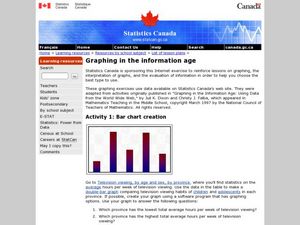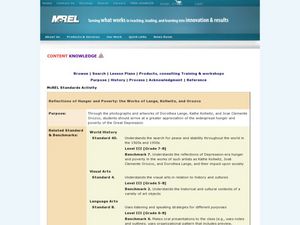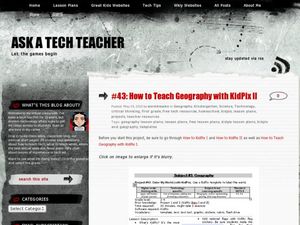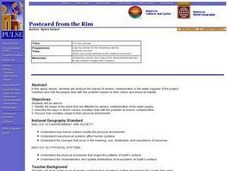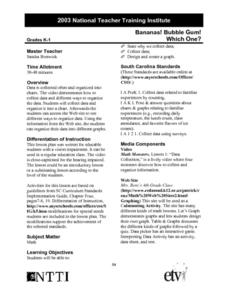Curated OER
Heritage: 'And Should We Die...' Attributes of the Pio
Eighth graders use comprehension strategies after reading to reflect on, consolidate, and extend meaning. They show various attributes of the pioneers through character sketches.
Curated OER
Using Math with Sale Papers
Fifth graders estimate their results and then prove through calculations. In this math lesson, 5th graders solve problems using multiplication, division, addition, and subtraction. They also use mental math to solve their problems.
Curated OER
Working Worms
Fourth graders examine earthworms. For this earthworm lesson, 4th graders investigate how earthworms help prepare soil for planting. Students examine other living and nonliving elements in a garden habitat.
Curated OER
Utah's Own
Fourth graders examine the effects of humans on the environment. In this Social Studies activity, 4th graders analyze human changes to the environment. Students explore the actions and effects at a community level.
Curated OER
Food Systems Feed the World
Fifth graders explore nutrition by viewing video clips discussing world hunger. In this malnutrition lesson plan, 5th graders discuss the reasons people cannot afford food in rural areas and read assigned text discussing our agriculture...
Curated OER
Grocery Store Problem Solving
Sixth graders explore the effect of healthy diets and exercise on physical and mental wellness. In this health activity, 6th graders compare food intake to the Dietary Guidelines for Americans. Students evaluate levels of activity and...
Curated OER
Hunger and Malnutrition
Sixth graders use a variety of resources to determine the importance of getting the proper nutrients. In this nutrition lesson, student complete an activity in which they examine the world issue of hunger and malnutrition. They locate...
Curated OER
Breads Around the World
Sixth graders explore world cultures by researching dietary habits. In this bread identification lesson, 6th graders explore different regions around the world and the types of breads they produce. Students read assigned text about the...
Curated OER
Clothesline Sleuth
Sixth graders investigate the origins of clothing production. In this Social Studies lesson, 6th graders examine the components of agriculture involved in making clothes. Students research cotton.
Curated OER
Multiplication Strategies and Writing Story Problems
Third graders model multiplication problems using Unifix cubes. They compute and solve problems involving addition and subtraction of 3- and 4- digit numbers and basic facts of multiplication and division. They practice mental math...
Curated OER
Rights in Conflict
Learners study situations where rights are in conflict. In this conflict in rights lesson, students review a conflict situation and the Supreme Court ruling for the issue. Learners review the Bill of Rights and then receive their own...
Curated OER
Inchworm
Young scholars discover the basic concept of measuring. In this mathematics relationship lesson, students identify length, volume, weight, time and area in order to measure different units. Young scholars measure items using different...
Curated OER
History of Computers II
Young scholars review the history of computers. They familiarize themselves with vocabulary associated with computer usage. Students watch a video that chronicles the history of computers and complete a KWL chart.
Curated OER
Juliette Low - Founder of the Girl Scouts
Second graders identify the founder of the Girl Scouts Juliette Low. They name reasons as to why clubs are created and brainstorm a list of other clubs they know about. They read the story "The Green Leaf Club News" and discuss why she...
Curated OER
American Indian Reservations
Fifth graders examine life on American Indian reservations, and discuss how confinement on the reservations affected American Indians. They visit the Bureau of Indian Affairs website, and develop positive and negative impact charts about...
Curated OER
Investigation 6 - Dinosaur Extinction
Fourth graders research and analyze theories on why dinosaurs became extinct. They need to find clues as to what the cause may have been. They record the evidence that they find to support their theory on the Dinosaur Extinction Theory...
Curated OER
Fat - A Concentrated Energy Source
Students study fats as a necessary part of a balanced diet. They match foods with visuals showing the amount of fats in each. They compare lunches and how substitutions of various foods can effect the fat content of each meal.
Curated OER
Graphing in the Information Age
Students create a variety of graphs based on population data. In this statistics instructional activity, students use data that can be gathered on-line to make a bar chart, line graph, and circle graph.
Curated OER
Reflections of Hunger and Poverty: the Works of Lange, Kollwitz, and Orozco
Students explore the Great Depression depicted in artwork. In this interdisciplinary lesson, students analyze artwork by Dorothea Lange, Kathe Kollwitz, and Jose Clemente Orozco. Students create brochures that feature details regarding...
Curated OER
How to Teach Geography with KidPix II
Students use the computer program KidPix II to color a map of the world. In this world map lesson plan, students fill in different colors for different continents that are told to them on the program KidPix II.
Curated OER
Friends in the Snow
Students practice reading a story in order to develop character recognition skills. They participate in reader's theatre in small groups to increase cooperation and fluency skills.
Curated OER
World Geography: Postcard from the Rim
Students are able to identify the areas of the world that are affected by arsenic contamination of the water supply. They are able to describe the ways in which various societies deal with the problem of arsenic contamination. ...
Curated OER
Naya Nuki's Journey
Pupils read "Naya Nuki Shoshoni Girl Who Ran" by Kenneth Thomasma. Students chart Naya Nuki's route on a map and identify the navigational signs she used to find her way home. Pupils also analyze the weather she encounters.
Curated OER
Bananas! Bubble Gum! Which One?
Students design and create a graph of data they have collected on their favorite candy bars. They explore how to organize data as well.



















